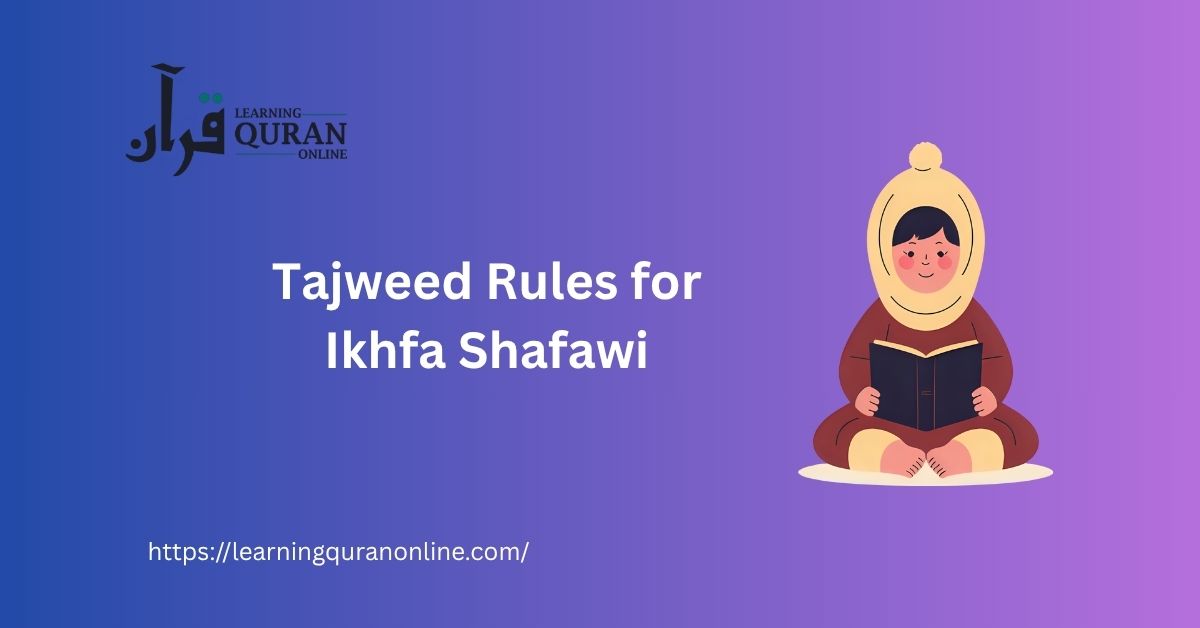Ikhfa’ Shafawi is a concise but essential tajweed rule every student of the Qur’an must master. Clear knowledge of meem sakinah rules helps turn correct recitation into beautiful recitation. In this blog you will learn what Ikhfa’ Shafawi is, when and how it applies, how it differs from the other meem rules (Idgham Shafawi and Izhar Shafawi), useful examples, common mistakes to avoid, and practical exercises to develop accuracy and fluency.
Table of Contents
ToggleWhat is Ikhfa’ Shafawi?
Ikhfa’ Shafawi (sometimes written “Ikhfa Shafawi” or “Ikhfa’ ash-Shafawi”) literally means “labial concealment.” It is a tajweed rule that applies when the letter meem with a sukoon (مْ — meem sakinah) is followed directly by the letter baa (ب). In this case the meem sound is not pronounced fully or clearly (izhar), nor fully merged (idgham); instead it is partially concealed and produced with nasalization (ghunnah).
Breaking down the term
– Ikhfa’ (إِخْفَاء) = concealment, hiding or partial hiding of the sound.
– Shafawi (شَفَوِي) = relating to the lips (shafah). The rule is called “shafawi” because both meem and baa are labial letters produced with the lips.
When does Ikhfa’ Shafawi occur?
Ikhfa’ Shafawi occurs under a single, simple condition:
- When a meem with sukoon (مْ) is followed immediately by the letter baa (ب) — whether inside one word or across two adjacent words.
Example phrase constructions where this happens (written in Arabic letters for clarity):
- هُمْ بَعْدَ (hum ba’da)
- أَمْ بَلَغَتْ؟ (am balaghat?)
- كُمْ بِنِعْمَةٍ (kum biniʿmah)
Articulation (Makhraj) and Characteristics (Sifaat)
Understanding the makhraj and sifaat helps produce the rule correctly:
- Makhraj: Both meem (م) and baa (ب) are labial letters produced with both lips. When performing Ikhfa’ Shafawi the lips briefly prepare for the baa while the meem sound is concealed.
- Ghunnah: Pronounce a nasal sound (ghunnah) for approximately two counts (two beats) while the meem is concealed; the nasalization is a defining characteristic.
- Concealment: The meem is not fully sounded as a clear “m” (izhar) nor is it completely merged into the following letter as in idgham meem→meem. Instead, the sound is hidden and transitions into a light b sound.
- Transition: After the ghunnah, release into the baa (ب) naturally. The lips complete the articulation of the baa following the nasal hold.
How Ikhfa’ Shafawi differs from other meem sakinah rules
There are three main rulings when encountering meem sakinah in tajweed. Understanding differences helps you choose the correct application immediately.
- Idgham Shafawi (م → م): When meem sakinah is followed by another meem (م). The two meems merge into one prolonged meem with ghunnah (two counts). Example: “يُمْ مِ” where the two meems join as a single nasalized meem.
- Ikhfa’ Shafawi (مْ → ب): When meem sakinah is followed by baa (ب). The meem is concealed with ghunnah and you transition to baa. This is our focus.
- Izhar Shafawi (other letters): If meem sakinah is followed by any letter other than م or ب, then the meem is pronounced clearly and fully (izhar) without ghunnah. Example: “مْ ت” pronounced as a clear meem then the next letter.
Practical examples and transliteration
Practice with short common phrases to internalize the rule. Below are example pairs showing each scenario. Notice the difference in sound and nasalization.
- Ikhfa’ Shafawi example: هُمْ بَعْدَ — pronounce with a brief nasalization on the hidden meem then move to بَعْدَ (hum ba’da).
- Idgham Shafawi example: مِنْ مَسْأَلَةٍ — meem merging into the next meem producing a prolonged nasal meem sound.
- Izhar Shafawi example: أَمْ تَسْتَغْفِرُونَ — pronounce the meem clearly before the ت.
Rules of duration (length) for Ikhfa’ Shafawi
The ghunnah (nasalization) is held for approximately two counts (beats). This is the same duration commonly applied to other ghunnah situations (like idgham with ghunnah). Hold the nasal sound lightly — do not over-emphasize — and then smoothly articulate the baa.
Other Relevant Blogs:
- Tajweed Rules for Qalqalah
- Tajweed Rules for Ghunna
- Tajweed Rules for Meem Saakin
- Tajweed Rules for Noon Saakin and Tanween
- Tajweed Rules for Stopping and Starting
- Tajweed Rules for Madd
- Tajweed Rules for Ikhfa
- Tajweed Rules for Idgham
- Tajweed Rules for Iqlab
Common mistakes and how to avoid them
Students frequently make a few predictable errors when applying Ikhfa’ Shafawi. Recognizing them helps you correct your recitation faster.
- Pronouncing a clear “m” (Izhar) before baa: This removes the concealment and ruins the intended sound. Fix: focus on hiding the meem and starting the ghunnah.
- Over-merging like idgham: Treating meem→baa as if it were meem→meem (complete merge) is incorrect. Fix: remind yourself that baa is a different letter and requires concealment, not full assimilation.
- Holding ghunnah too long or too short: Too long makes recitation heavy; too short makes the rule inaudible. Aim for two counts of nasalization.
- Not preparing the lips: Since both letters are labial, coordinate both lips so the transition is smooth from concealed meem to pronounced baa.
Step-by-step practice method
Follow this progressive practice routine to master Ikhfa’ Shafawi:
- Listen: Choose a qualified reciter (qari) and listen closely to examples where meem sakinah is followed by baa.
- Identify: Read through a Quranic page and highlight words/phrases with مْ + ب.
- Slow practice: Recite the highlighted phrases slowly, focusing on hiding the meem and producing two counts of ghunnah.
- Mirror & record: Use a mirror to watch your lip movement and record yourself to compare with the reciter.
- Increase speed: Gradually return to normal recitation speed while maintaining correct articulation.
- Reinforce: Repeat daily and use minimal pairs (مْ + ب vs مْ + م vs مْ + ت) to feel the differences.
Exercises (recommended)
Try these short drills:
- Drill 1: Repeat the phrase “هُمْ بَعْدَ” ten times, focusing on two-count ghunnah and smooth transition.
- Drill 2: Read lines of the Qur’an and underline every occurrence of مْ followed by ب; practice each occurrence in isolation.
- Drill 3: Create minimal pairs—say a line with مْ + ب, then the same line with مْ + م, then with مْ + ت—to feel how the mouth and nasalization change.
Why mastery of Ikhfa’ Shafawi matters
Learning Ikhfa’ Shafawi is more than a technicality. Correct application:
- Preserves the phonetic integrity of the Qur’anic recitation passed down by the Prophet ﷺ.
- Improves clarity and beauty of recitation — listeners can distinguish words correctly.
- Prepares students for tajweed tests and formal recitation settings (e.g., competitions or mosque recitation).
Helpful resources and next steps
– Work with a qualified tajweed teacher who can give immediate feedback and model the subtlety of the ghunnah.
– Use audio recordings of well-known qaris and compare your recordings.
– Practice consistently — daily short sessions (10–20 minutes) are far more effective than occasional long sessions.
Conclusion
Ikhfa’ Shafawi is a short but powerful rule that refines your Quran recitation. Once you can identify meem sakinah followed by baa and apply the two-count ghunnah with labial concealment, your recitation will sound more accurate and melodious. For structured lessons, guided practice and direct teacher feedback, consider joining professional classes — Learning Quran Online offers tajweed-focused instruction to help you master rules like Ikhfa’ Shafawi with confidence.
Practice regularly, listen to skilled reciters, and correct mistakes fast by comparing recordings. With patient, focused effort you will notice steady improvement in both accuracy and beauty of your recitation.










